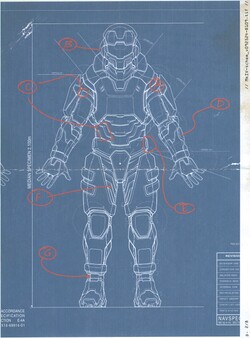MJOLNIR Powered Assault Armor/Mark IV
From Halopedia, the Halo wiki
- "You're the only ones who can use them, Petty Officer. Who else could we give them to?"
- — Dr. Halsey
The Mark IV MJOLNIR Powered Assault Armor was the fourth version of the MJOLNIR Powered Assault Armor series. The suit was issued to SPARTAN-II commandos on November 27th, 2525,[1] and was in service until November 24th, 2551, when it was replaced by the Mark V.[2] The Mark IV underwent many physical changes during nearly three decades of service.[3]
Introduction
Created parallel to the SPARTAN-II Program,[4] the MJOLNIR Mark IV Armor was a radical redesign to previous powered exoskeletons, streamlining their design into a practical purpose for use in the field. The brainchild of Dr. Catherine Halsey, the Mark IV represented her vision of creating a powered exoskeleton capable of taking full advantage of the physical capabilities of a SPARTAN-II.[4] The MJOLNIR battlesuit is constructed in overlapping layers. It is a sealed system, capable of extravehicular activity or operations in toxic atmosphere and vacuum. It is hardened against EMP and radiation, and has filters that are completely effective at removing toxins and bacteria from local atmosphere.[5][note 1][6]
The armor's shell is composed of a multilayer alloy of remarkable strength which has been augmented with a refractive coating capable of dispersing a limited amount of Covenant energy weapon strikes.[5][7] The suit contains a gel-filled layer underneath a thick black armored bodysuit. The gel layer regulates temperature and can reactively change its density in a few seconds.[5][7] The inner skinsuit is made of a moisture-absorbing synthetic material linked to an environmental control computer and the occupant's UNSC-issue neural interface.[5][7] An upgrade to the standard Neural Interface is issued to all high ranking officers; another modified version of the neural lace is issued to all SPARTAN-IIs in the UNSC as well. This network translates electrochemical signals to digital code and routes them through an interface connection at the rear of the skull.[5] Through this interface, the user's thoughts commands the armor's movement and weapons and input from the on board sensors comes directly to the user's mind.[5] The synthesis of machine and mind is so fast that it is almost impossible to chart the reaction time. Unfortunately, the system is so reactive that normal human beings cannot use the suit without injuring or even killing themselves.[8] Only humans who have undergone carbide ceramic ossification, a bone-strengthening treatment from the SPARTAN-II augmentation program, have been shown to safely operate the suit.
Sandwiched between the external armor and the internal padding is the most devastating weapon the suit carries: a layer of reactive metal liquid crystal.[5] Woven by molecular tools into a superdense layer, this layer is amorphous, yet it amplifies force, doubling lifting capability and increases reaction time by a factor of five.[4] Such technology did not exist when work began on the Mark I prototypes.[4][9]
Because of these advancements, the design is more akin to an actual suit of armor, as opposed to a powered exoskeleton; the user moves the suit, and in return the suit moves the user. This allows for an incredibly compact design when compared to other combat systems. The armor contains numerous features including an integrated computer system which continuously monitors weapons, biological functions, and an intelligent motion-sensing radar. The suit also contains a built-in oxygen re-breather system that can provide air for up to ninety-minutes.[6] The suit's helmet also features imaging and video recording, and thermal sensors among other features.
In its final phase the MJOLNIR battle suit weighs half a ton[10], or 1000 LBs and when in use, is a fully neural-linked system and is currently the most advanced piece of tactical military hardware in human hands.[5]
Armor variants
Throughout the Human-Covenant War, the Mark IV became a testing bed for new technologies and hardware to help improve the integrity of both the system and the efficiency of it in certain combat conditions. While some of these variants of the Mark IV MJOLNIR armor are rumors and have never been witnessed in the field, some have become common knowledge.[11]
Mark IV MJOLNIR Powered Assault Armor/Advanced Hardware Prototype
The MJOLNIR advanced hardware prototype refers to a series of hardware and technologies developed for testing and incorporation into later versions of the MJOLNIR Armor. The advanced prototype is a single variant, that changes in appearance for research and development of future MJOLNIR components.[11]
Mark IV MJOLNIR Powered Assault Armor/V variant
- Main article: MJOLNIR Powered Assault Armor/V variant
The MJOLNIR Mark IV Extra Vehicular Activity variant was developed to focus on increasing exo-atmospheric endurance and improving mobility in zero gravity. The movement could be controlled with the use of a T-PACK, or Thruster Pack, attached to the armor. This was not without dangers however; in case the T-PACK would malfunction, the wearer would be propelled into deep space where a rescue would be nearly impossible. The V variant of the MJOLNIR armor contains a reverse-angle camera on the helmet to allow for better view of anything behind the wearer. The helmet also contains a single-beam laser TEAMCOM system for communications. The only limitation of this variant is the mobility of the wearer is a fraction of normal movement.[12] Technologies developed for the Mark IV EVA variant were later applied for the V Variant of the Mark VI armor. However, this version was able to maneuver in vacuum without the original use of thruster packs.
Mark IV MJOLNIR Powered Assault Armor/Grenadier Variant
- Main article: Mark IV(G) MJOLNIR Powered Assault Armor
The Mk. IV [G] variant is an up-armored prototype based on the basic Mk. IV helmet. Two uprades are availible for the helmet, the first adds an Up-Armor plate (UA), and the second adds an Up-Armor plate with a Command Network Module on the left side and a Hardened Uplink Module on the right side (UA/FC). It is unknown what FC stands for, but it is the term used when a CNM and HUL are equipped together.
Armor Components
- Helmet: The MJOLNIR Helmet is one of the most vital aspects to the MJOLNIR system. It is made of Titanium and contains key features like a Heads Up Display that links to the brain and hands, and can identify equipment and display information about it when it is picked up by the wearer. Another feature is the direct neural interface system which connects to a SPARTAN-IIs neural implants. Two core processor chips are implanted into the subjects skull in the rear of the head. This is essentially comparable to an on board computer using parts of the human brain for processing - when the connector at the rear of the subjects head and receptors in the brain link to the helmets on board sensors it creates the neural link needed to move the MJOLNIR suit. The helmet also contains other equipment to protect and aid the user in hostile conditions. This includes: filters to remove toxins from the atmosphere, a supply to provide air to the wearer during EVA, thermal and motion sensors, communications, solar-powered lighting, and imaging and video gear.
- Titanium alloy outer shell: The outer shell of the MJOLNIR armor is comprised of a fairly thick titanium alloy. This plating covers the chest, arms, hip, legs, calf's, feet and hands. This alloy is very resilient, can take significant punishment, and is nearly impervious to small arms fire. While enough shots from armor piercing rounds will breach the outer shell, the suit can take a few glancing blows from them without compromising the armor. The outer shell of the MJOLNIR suit is covered with a refractive coating to help disperse the heat experienced from Covenant energy weapons. However one or two direct hits from any Plasma weapon will compromise the armor plating.[13]
- Titanium nanocomposite bodysuit: Sandwiched between the external armor and the internal padding is a thick black armored bodysuit. This suit has numerous functions, small but vital to the safety and survival of the wearer. The bodysuit is made of a titanium-based material, making it very strong and yet very flexible. It also serves as another layer of protection against ballistics attacks and is coated with a heat resistant material to disperse heat from plasma weapons.[13]
- Hydrostatic Gel: Underneath the armored bodysuit is a gel-filled layer, this gel layer regulates the temperature of the suit and can change its density to conform to the wearer's shape - the temperature inside the suit is controlled by the moisture absorbing cloth suit underneath the hydrostatic layer. The hydrostatic gel layer can also be pressurized to various levels to potentially save the wearers life should the wearer be subjected to high G forces or a high velocity impact; however, over pressurizing this layer can cause nitrogen embolisms.[14][15]
- Reactive Metal Liquid Crystal Layer: Liquid crystal forms the inner structure of the suit. This reactive metal increases the strength, reaction time, mobility, speed, and all around physical performance of the SPARTAN-II. This layer of crystal, knitted together at a molecular level and fitted in between the outer plates and the inner padding. This type of crystalline improves reaction time, strength and durability; as such this layer accounts for over eighty percent of the MJOLNIR armors cost of construction and materials.[11]
- Magnetic weapon holder strips:Available on the Mk. IV, Mk. V, and Mk. VI, the magnetic strips are very small yet powerful magnets placed on the legs, waist, and back of the suit and is used to hold any equipment with a magnetic property. The suit also contains a magnet system on the boots of the MJOLNIR suit that allow its wearer to stay attached to a metal surface in Zero G environments and can be toggled on or off by the wearer.
- Pressure Seal: The Pressure Seal is a vital component to the MJOLNIR system, it keeps the system airtight, underwater or in space. The seal is very strong but will only break under extreme pressure, such as in a high velocity impact or when the Hydrostatic Gel has been over pressurized.
- Biofoam injector port: The biofoam injectors on the Mark IV is a port where a direct supply of biofoam or other medicines, must be administered from a standard military first aid kit when the wearer is injured, as the suit does not hold or generate its own supply inside the suit.
- Fusion reactor: The fusion reactor is the most essential part of the MJOLNIR System, as it provides power to all equipment on the MJOLNIR armor, the reactor is built into the suit and allows for nearly unlimited movement. The fusion reactor in all versions of the MJOLNIR armor are half the size of a normal fusion pack that conventional marines carry around.[16]
Appearances
The visual appearance of the MJOLNIR Mark IV has varied in different media, leading to confusion over whether these are separate variants or are the result artistic license.[note 2] However, it has since been shown that several versions, including the baseline model, the suit worn by Gray Team, the suit worn by Red Team, and the model used during the mission to rescue Halsey are distinct variants of the Mark IV. Despite their different superficial appearances, they share the same internal components.[17][18]
Halo: The Cole Protocol
The Cole Protocol cover design of the Mark IV depicts it as a very rough, yet familiar in recognition to later incarnations of the MJOLNIR armor. Its chest plate is more angular than that of the other versions, somewhat reminiscent of the Mark V. The helmet of the Mark IV shows hints in design to both the Mark V and Mark VI helmet. The shoulder pauldrons consist of a semi-circular plate of metal to allow more freedom of movement in the shoulder area. The back shoulder plates also appear to be removable to attach additional equipment.
Halo Wars/Legends/The Fall of Reach
This version was introduced in Halo Wars, and has appeared in several titles produced by 343 Industries, including the Halo Legends episodes The Babysitter and Origins, as well as the 2010 cover of Halo: The Fall of Reach. In this version, the armor plating for the body, arms and legs are more akin to the Mark VI, with a bulky, angular chest plate and large, bulbous shoulder pauldrons. The helmet in terms of design is almost exactly like the Mark V's, and both Dr. Halsey's personal journal and the Halo: Reach Armory clarify that they are the same helmets, adapted for use on the later armor model.[19][20] The armor also has magnetic holders for magazines and weapons.[note 3]
The Package
In The Package, the Mark IV armor is almost visually identical to the Mark VI, despite some differences in the proportions and the details, such as having larger rougher shoulder pauldrons. There are slight differences in the helmets as well. Each SPARTAN's number is also printed on the chest plate of the armor along with other markings such as white stripes in the chest and the shoulders. This version has magnetic holders for weapons as well as a sheath for a combat knife to be attached on the shoulder pauldrons.[note 4]
Homecoming
The Mark IV worn by Daisy-023 in Homecoming resembles the MJOLNIR/C variant, but is otherwise largely unrelated to it.[note 5] The appearance of the armor is a stylistic and aesthetic nod towards multiplayer fans who use different colors in various environments and the various armor permutations, as well as an aesthetic concession to the anime studio as a means of possessing visual variety.[21]
Gallery
- 1226682598 SpartanmarkIVarmor2.JPG
A render of the Mark IV Armor of Halo Wars as seen in 360 Magazine.
- Halo Character Spartan Render.jpg
A render of the near-final design of the Mark IV armor.
- Spartan.JPG
Concept render of the Halo Wars Mark IV.
Cal-141's Mk. IV armor, as seen in The Babysitter.
The 2010 cover of Halo: The Fall of Reach showing John-117 in Mk. IV.
Notes
- ^ The reference, Master Chief's Armor: An Overview, was posted on xbox.com before the release of Halo: Combat Evolved. It is an official excerpt from the Halo Story Team. However, the article has been removed from xbox.com and there are few websites that have re-posted the article, including the old Halo timeline that article can be viewed here.
- ^ This section is here in part to bring together a difference of opinions pertaining to the design of the MJOLNIR Mark IV, using what information is available and combining them into a single as factual as can be entry. No official source has defined if the Halo Wars or The Cole Protocol version is the standard variant. Please refer to the talk page for questions or issues.
- ^ Halo Wars portrays the Mark IV with energy shields. This is a liberty taken by the developers for the sake of gameplay, as stated here.
- ^ In Halo: Legends, most of the designs for characters, armor, and so forth are portrayed with considerable artistic interpretation and may or may not be embraced as canon. However, a video on Halo Waypoint has revealed that the Mark IV suit featured in The Package is one of several variants, which, despite its appearance, shares its internal components with the rest of the Mark IV line.
- ^ The armor description for the CQC variant in Halo: Reach Multiplayer Beta states that the CQC variant, the precursor for the C variant, entered service in 2548, thus making it impossible for the C variant to have been in use around twenty years earlier. In addition, the C variant was developed using feedback from the Battle of Jericho VII, which occurred years after the Harvest Campaign. The direct's commentary for the episode reveals that the armor's appearance is largely an aesthetic concession to the studio to allow for some visual variety for the character, and as a nod towards multiplayer fans who use armor permutations, such as the CQC variant. The same is true for the armor's color, though this is also representative of an effort to camouflage the suit. This means that other than the suit's color, the armor's appearance is non-canon.
Sources
- ^ Halo: The Fall of Reach, page 113
- ^ Bungie.net: Bungie Weekly Update: 01.29.10
- ^ Halo Waypoint: MJOLNIR
- ^ a b c d Sybex Halo PC Strategy Guide, page 5
- ^ a b c d e f g h Master Chief's Armor: An Overview
- ^ a b Halo: The Fall of Reach page 120
- ^ a b c Halo: The Fall of Reach page 114-115
- ^ Halo: The Fall of Reach, page 115
- ^ Halo: The Fall of Reach page 70
- ^ Halo: The Fall of Reach page 2
- ^ a b c Halo Encyclopedia pages 88-89
- ^ Halo: Ghosts of Onyx, Chapter 3, pages 49-50 Chapter 4, page 57
- ^ a b Halo Encyclopedia page 90
- ^ Halo: First Strike page 13
- ^ Halo: Ghosts of Onyx page 36
- ^ Halo: The Fall of Reach page 114
- ^ Frank O'Connor's comment regarding the Mark IV
- ^ Halo Waypoint: The MJOLNIR Project 2
- ^ Dr. Halsey's personal journal
- ^ Halo: Reach - The Armory, Mark V permutation description
- ^ Halo Legends - Homecoming, director commentary.






